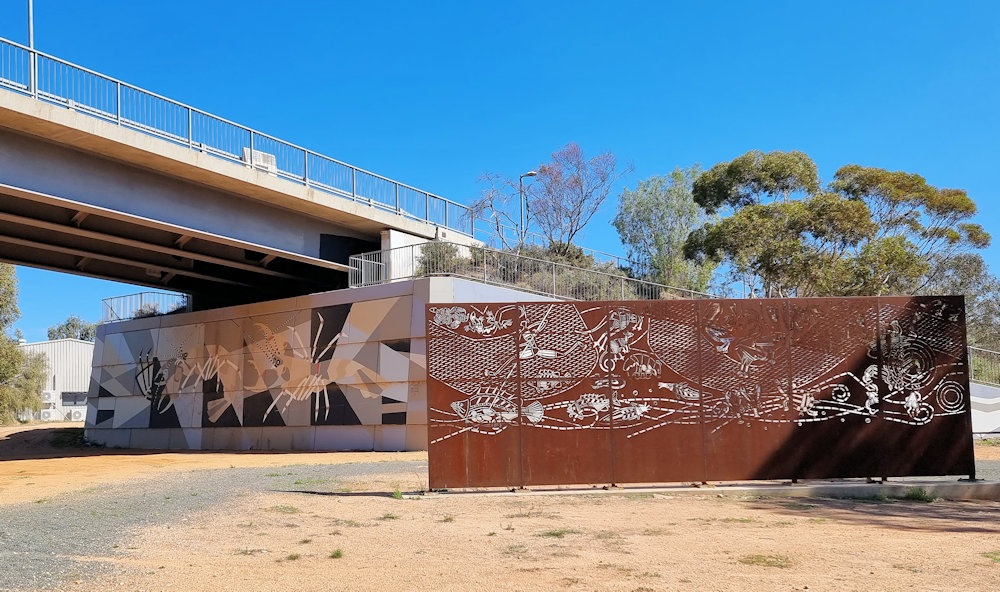Berri Bridge Mural
The Berri Bridge Mural, located beneath the Sturt Highway bridge across the Murray River in South Australia, is one of the Riverland’s most significant public artworks. It blends community effort, Indigenous storytelling, and regional identity into a single, striking visual statement.
First completed in 1997, the mural was commissioned by Transport SA, now the Department for Infrastructure and Transport. The goal was to enrich a utilitarian structure with art that reflected the land and its people. However, the result became something much greater — a lasting expression of cultural continuity and shared creativity.
Artist Garry Duncan, already well known for his environmental murals and public works, led the project in partnership with four Indigenous artists from the region: Shane and Jason Karpany, Isaac Lindsay, and Gladys Sumner. Together, they created a large-scale interpretation of the Ngurunderi Dreaming Story, a narrative central to the Ngarrindjeri people of the Murray River and Coorong regions. The story explains the river’s creation and the shaping of the landscape that defines much of southern South Australia.
From the beginning, the project was more than an artwork. It represented a collaboration between cultures and generations. It allowed Indigenous artists to work under mentorship while contributing their own cultural perspectives and designs. Moreover, it turned an ordinary river crossing into a space for storytelling, reflection, and pride.
The Ngurunderi Dreaming
At the heart of the mural lies the Ngurunderi Dreaming, one of the great creation stories of the Murray River. The Dreaming tells how Ngurunderi, a powerful ancestral being, travelled down the river in search of his runaway wives. As he journeyed, he shaped the landscape and established laws for his people.
Along the way, a giant cod named Ponde helped carve out the course of the Murray with the sweep of its tail. This act created the river’s bends, islands, and floodplains. Ngurunderi’s journey extended all the way to the river’s mouth, forming many natural features recognised today — including Long Island and the Coorong.
The Berri Bridge Mural expresses this story in visual form. Flowing motifs depict the movement of water and the rhythm of the landscape. Figures and symbols show the path of Ngurunderi, while the shapes of fish, birds, and animals link the natural world to spiritual meaning. Through colour and design, the mural celebrates the connection between the Ngarrindjeri people and their environment — a relationship that has lasted tens of thousands of years.
Importantly, the mural brings an ancient story into a contemporary setting. By placing Dreaming imagery beneath a modern bridge, the artists created a dialogue between past and present. The work invites both locals and travellers to pause and consider the depth of history flowing beneath their feet.
Collaboration and Creation
The mural’s creation in 1997 was a large community effort. Berri residents, local schools, and regional groups supported the artists as they worked on-site beside the river. Many local people recall seeing the huge Jarrah timber panels — chosen for their strength and natural beauty — being painted and assembled under the bridge.
Garry Duncan’s role was to coordinate the project and mentor the emerging Indigenous artists. His experience with environmental art helped shape the mural’s layout, while the Ngarrindjeri artists brought their cultural knowledge and personal styles. This blend of artistic approaches produced a powerful, unified design that spoke both to ancient tradition and modern creativity.
The imagery combined symbolic representation and narrative flow. Abstract patterns suggested water and wind, while figurative elements portrayed people, animals, and spirits. The choice of colours — rich ochres, river blues, and muted greens — reflected the tones of the Murray landscape.
For the artists, the project became a form of storytelling on a monumental scale. For the community, it offered a shared expression of identity and respect. Even after its completion, the mural continued to inspire pride and conversation among those who lived nearby or passed through the Riverland.
Renewal and Restoration
After two decades exposed to the elements, the original Jarrah panels began to deteriorate. Weathering, sunlight, and termite activity damaged the wood, threatening to erase the artwork. However, rather than allow the mural to fade, the community chose renewal.
In 2017, the project’s original artists reunited to restore and reinterpret their work. Led once again by Garry Duncan and Shane Karpany, the new design introduced both painted and sculptural elements. The artists replaced the damaged timber with laser-cut steel panels, which now stand at the entrances of the Ngurunderi Dreaming Trail along the riverbank.
The updated artwork maintained the spirit of the original while adapting it to new materials and technologies. Steel, unlike timber, offered durability and a reflective quality that interacted with light and water. Meanwhile, the bridge pylons themselves became canvases for fresh painted imagery, ensuring the story remained visible from the river and nearby walkways.
Throughout the restoration, the artists remained faithful to the Ngurunderi Dreaming narrative. The renewal symbolised continuity — a reminder that cultural stories evolve but never disappear. The process also reinforced local collaboration, with councils, artists, and community members working together once more.




Leave a Reply